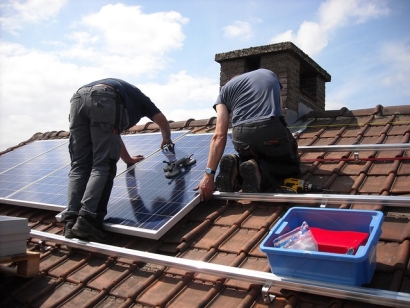
The renewable energy industry does require working with some unpredictable energy sources, like the sun or wind and that can have risks. The potential risks that can come from transforming these resources into power include working at great heights, misuse of machinery, fires, confined spaces, and electrical currents.
The first risk in renewable energy can come from machinery misuse. This tends to happen most with geothermal pumps or wind turbines. Photovoltaic modules needed for solar energy can also cause injury. To avoid machinery misuse, prioritize having your operators take training courses and ensure the equipment is properly maintained.
Falls can happen while performing repairs to wind turbines, which can be about 250 feet tall, or while repairing overhead electrical power lines. Any work being completed on equipment over 6 feet from the ground requires an arrest device to secure the worker safely. Another crucial way to avoid fall hazards is to make sure that equipment, such as a lift or crane, is operated by a qualified and licensed worker. A lift is equipped with a guardrail system, and there are also safety net systems to put in place for additional security in a fall-hazard situation.
Electrical currents pose another safety risk in the renewable energy industry. An electrical current can cause burns and shock from the electricity traveling through an overhead power line or in a solar panel during installation. While working on overhead power lines, it is recommended to stay 10 feet away from overhead power lines and to take extra care and precaution that tools and equipment are out of reach too.
Fires can be caused by steam, heat, dust, pressure, and electricity. Workers must carefully dispose of “hot load” (solid waste with thermal activity) properly. Some energy sources contain hazardous chemicals and gases, so it is very important that precautions are taken during production, manufacturing, and while working onsite. It is recommended that workers and operators wear long sleeve shirts and long pants or other clothing to help protect against heat and steam.
Renewable energy may require work in a confined space for repairs or maintenance. A side effect of being in a confined space could be poor ventilation. Poor ventilation can cause low oxygen levels which can cause asphyxiation. It is recommended to use an axial or centrifugal blower to help with airflow while in these small areas.
Working in confined areas is common in the wind sector because of the interior work and operation needed for the turbines. The interior of these turbines or other confined spaces may contain live wires and unguarded machinery.
It is recommended to use hoists and self-retracting lines to help remove the worker in any emergency situation and use a gas monitor to help stay aware of the changing conditions in the space.
The importance of safety mitigation in the renewable energy industry is to establish expectations that give specific guidelines on what to do in case of an emergency.
The guidelines can include how to maintain equipment with regular maintenance, how often to complete inspections, training requirements for equipment, and the use of PPE (personal protective equipment).
Workers should know when to wear respirators, hard hats, hearing protection, and safety glasses. Workers and equipment operators should all complete training requirements for first aid and all equipment on site. It is especially important that each person complete a first aid course specific to their industry and workplace that can be customized for emergency care in remote locations if needed.
Safety in the renewable energy industry is so important and requires everyone's involvement. The expectations and protocols should be clear and easy to understand so everyone knows what to do on a daily basis as well as in emergencies.
It is crucial to make sure everyone is aware of the risks but also has the knowledge to be able to protect themselves or others if the situation becomes dangerous.

